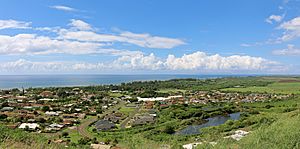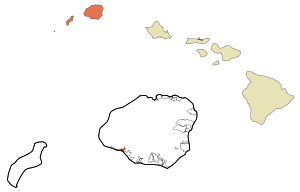Waimea, Kauai County, Hawaii facts for kids
Quick facts for kids
Waimea, Hawaii
|
|
|---|---|

View overlooking the town and Waimea Bay
|
|

Location in Kauai County and the state of Hawaii
|
|
| Country | United States |
| State | Hawaii |
| Counties | Kauai |
| Area | |
| • Total | 2.18 sq mi (5.64 km2) |
| • Land | 1.85 sq mi (4.80 km2) |
| • Water | 0.33 sq mi (0.85 km2) |
| Elevation | 9 ft (3 m) |
| Population
(2020)
|
|
| • Total | 2,057 |
| • Density | 1,110.69/sq mi (428.88/km2) |
| ZIP Code |
96796
|
| Area code(s) | 808 |
| FIPS code | 15-78800 |
| GNIS feature ID | 364794 |
Waimea is a small town in Kauaʻi County, Hawaiʻi, United States. Its name means "red water" in the Hawaiian language. Waimea is located on the southwest coast of the island of Kauai. In 2020, about 2,057 people lived there.
Waimea is famous because it was the first place in Hawaii where Europeans landed. This happened in 1778. Because of this, some people jokingly call Kauai "Hawaii's Original Visitor Destination."
Contents
History of Waimea
Early Settlers in Kauai
The first people arrived in Kauaʻi between 200 and 600 AD. They came from the Marquesas Islands. We don't know exactly why they left their homes. Maybe they were escaping wars or hunger, or perhaps they just wanted to explore new lands.
These early travelers brought important things with them. They brought plants like taro and sweet potato. They also brought animals like pigs and chickens. These settlers were skilled farmers and fishermen. They used clever ways to water their crops, which helped them live well on the island.
Tahitian Explorers and the Kapu System
Around 1000 AD, new explorers arrived in Hawaiʻi from Tahiti. They took over from the Marquesans. Hawaiian stories say that the smaller Marquesans were chased into the hills. They became known as the "Menehune," who were sometimes thought to bring bad luck.
The Tahitians brought a new way of life. They set up a strict social system with clear rules called "kapu." These rules were very important. For example, men and women were not allowed to eat together. Women could not eat pork or bananas. Also, no one was allowed to step on the shadow of a royal person. This kapu system, led by kings called aliʻi, lasted for hundreds of years. It was still in place when Western explorers first arrived.
Captain Cook's Arrival in Waimea
On January 20, 1778, a British explorer named Captain James Cook arrived in Waimea. He sailed with his ships, the HMS Discovery and Resolution. Cook sent smaller boats to check out the Waimea River. His men found a freshwater lagoon and a native village. So, Cook and his crew anchored their ships and went ashore.
Captain Cook's trip was meant for science and exploration. His men wrote down details about the plants and animals in Waimea. They also tried to learn the language of the native people. This first meeting was quite friendly. One of Cook's men wrote that the natives showed great respect and friendship. They even bowed down to him, which was a sign of honor.
Cook's arrival was the first time Westerners met Hawaiians. It led to a lot of new information about Hawaii's nature and culture. However, it also marked the start of a difficult time for the Hawaiian people. Europeans brought new diseases, like tuberculosis. These diseases caused many native Hawaiians to become sick and pass away.
Waimea's Economy
In the late 1700s and early 1800s, Waimea was a busy trading center. People traded things like animal furs, whale products, and sandalwood. Later, the sugar industry became very important in the 1800s.
Today, the main jobs in Waimea are in construction and tourism. There are two hotels in town: Waimea Plantation Cottages and The West Inn motel. You can also find several shops, small restaurants, and food trucks. These places serve both local people and tourists. Waimea is also home to the first Jo-Jo's Shave Ice and the main office for Aunty Lilikoi, a company that makes condiments.
Geography of Waimea

Waimea is located at 21°57′42″N 159°40′25″W. The town covers about 1.3 square miles (3.3 km²). Most of this area is land, with a small part being water.
Waimea is a popular spot for visitors. Many people come here to hike through the nearby canyons and along the ridges.
Climate in Waimea
Waimea has a Tropical savanna climate. This means it is warm all year round. It also has a wet season and a dry season.
| Climate data for Waimea, Hawaii, 1991–2020 normals, extremes 1969–2017 | |||||||||||||
|---|---|---|---|---|---|---|---|---|---|---|---|---|---|
| Month | Jan | Feb | Mar | Apr | May | Jun | Jul | Aug | Sep | Oct | Nov | Dec | Year |
| Record high °F (°C) | 88 (31) |
87 (31) |
89 (32) |
91 (33) |
93 (34) |
95 (35) |
94 (34) |
94 (34) |
93 (34) |
92 (33) |
97 (36) |
88 (31) |
97 (36) |
| Mean maximum °F (°C) | 83.4 (28.6) |
83.0 (28.3) |
84.6 (29.2) |
85.7 (29.8) |
87.2 (30.7) |
88.8 (31.6) |
89.6 (32.0) |
90.2 (32.3) |
90.1 (32.3) |
89.0 (31.7) |
87.1 (30.6) |
84.7 (29.3) |
90.9 (32.7) |
| Mean daily maximum °F (°C) | 79.5 (26.4) |
79.5 (26.4) |
80.1 (26.7) |
82.2 (27.9) |
83.9 (28.8) |
85.6 (29.8) |
87.0 (30.6) |
87.4 (30.8) |
87.3 (30.7) |
85.6 (29.8) |
83.2 (28.4) |
80.6 (27.0) |
83.5 (28.6) |
| Daily mean °F (°C) | 70.8 (21.6) |
70.5 (21.4) |
71.9 (22.2) |
73.4 (23.0) |
75.3 (24.1) |
77.1 (25.1) |
78.3 (25.7) |
78.5 (25.8) |
78.3 (25.7) |
76.9 (24.9) |
74.7 (23.7) |
72.4 (22.4) |
74.8 (23.8) |
| Mean daily minimum °F (°C) | 62.0 (16.7) |
61.5 (16.4) |
63.6 (17.6) |
64.5 (18.1) |
66.7 (19.3) |
68.6 (20.3) |
69.6 (20.9) |
69.7 (20.9) |
69.3 (20.7) |
68.2 (20.1) |
66.3 (19.1) |
64.3 (17.9) |
66.2 (19.0) |
| Mean minimum °F (°C) | 57.2 (14.0) |
56.5 (13.6) |
58.8 (14.9) |
60.2 (15.7) |
62.3 (16.8) |
64.8 (18.2) |
66.0 (18.9) |
66.6 (19.2) |
65.6 (18.7) |
64.1 (17.8) |
62.1 (16.7) |
58.5 (14.7) |
54.4 (12.4) |
| Record low °F (°C) | 43 (6) |
43 (6) |
52 (11) |
49 (9) |
53 (12) |
57 (14) |
56 (13) |
59 (15) |
58 (14) |
52 (11) |
52 (11) |
53 (12) |
43 (6) |
| Source 1: NOAA | |||||||||||||
| Source 2: XMACIS2 (mean maxima/minima 1981–2010) | |||||||||||||
People in Waimea
| Historical population | |||
|---|---|---|---|
| Census | Pop. | %± | |
| 2020 | 2,057 | — | |
| U.S. Decennial Census | |||
In 2000, there were 1,787 people living in Waimea. They lived in 620 households, and 456 of these were families. The town had about 1,707 people per square mile.
The people in Waimea come from many different backgrounds:
- 12.7% were White
- 0.1% were African American
- 0.2% were Native American
- 43.0% were Asian
- 12.3% were Pacific Islander
- 1.1% were from other races
- 30.6% were from two or more races
- 7.2% of the population were Hispanic or Latino.
About 33.2% of households had children under 18. About 52.3% were married couples. The average household had 2.80 people. The average family had 3.27 people.
The median age in Waimea was 41 years old. This means half the people were younger than 41 and half were older.
Culture and Events in Waimea
Waimea Town Celebration
Every February, Waimea hosts a big event called the Waimea Town Celebration. This festival started in 1978. Now, it lasts for nine days! It celebrates Hawaiian culture.
Some activities include:
- Honoring Kaumualiʻi, who was Kauaʻi's last king.
- A film festival.
- Concerts with music.
- A contest to make leis for cowboy hats.
- A rodeo.
- A canoe race.
- Many other sports events.
Historic Waimea Theater
The Historic Waimea Theater first opened on September 2, 1938. It is one of only two movie theaters left on the island of Kauaʻi. In 1992, Hurricane Iniki damaged the theater. The owner planned to tear it down.
However, a group called West Kauaʻi Main Street leased the building in 1993. They started to fix up the old theater. The County of Kauaʻi bought the building in 1996. In August 1999, the theater opened again to the public. It is now managed by the West Kauai Business & Professional Association.
Education in Waimea
Waimea has three public schools:
- Waimea Canyon Middle School
- Waimea High School (This is the westernmost high school in the United States!)
- Niʻihau High and Elementary School
See also
 In Spanish: Waimea (condado de Kauai) para niños
In Spanish: Waimea (condado de Kauai) para niños


